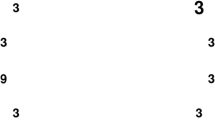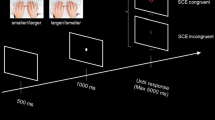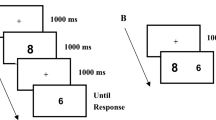Abstract
Numbers induce shifts of spatial attention on the left or the right sides of external space as a function of their magnitude. However, whether this number–space association is restricted to the linear horizontal extensions, or extends to the whole visual scene, is still an open question. This study investigates, by means of a cancellation paradigm, the influence of numerical magnitude during scanning tasks in which participants freely explore complex visual scenes unconstrained towards either the horizontal or the vertical unidimensional axes. Five cancellation tasks were adapted in which Arabic digits were used as targets or distracters, in structured (lines and columns) or unstructured visual displays, with a smaller (2 or 3 types of distracters) or larger (10 or more types of distracters) sets of stimuli. Results show that the participants’ hits distribution was a function of number magnitude: shifted on the left for small and on the right for large numbers. This effect was maximised when numerical cues were sparse, randomly arranged and, critically, irrelevant to the task. Overall, this study provides novel evidence from visuo-spatial exploratory cancellation tasks for an attentional shift induced by number magnitude.




Similar content being viewed by others
References
Axenfeld D (1894) Eine einfache Methode Hemianopsie zu constatiren. Neurologisches Centralblatt 13:437–438
Bowers D, Heilman KM (1980) Pseudoneglect: effects of hemispace on a tactile line bisection task. Neuropsychologia 18:491–498
Cappelletti M, Freeman ED, Cipolotti L (2007) The middle house or the middle floor: bisecting horizontal or vertical mental number lines in neglect. Neuropsychologia 45(13):2989–3000
Cattaneo Z, Silvanto J, Pascual-Leone A, Battelli L (2009) The middle range of the number line orients attention to the left side of visual space. Cogn Neuropsychol 26(3):235–246
Cattaneo Z, Fantino M, Tinti C, Silvanto J, Vecchi T (2010) Crossmodal interaction between the mental number line and peripersonal haptic space representation in sighted and blind individuals. Psychon Soc 72(4):885–890
Cohen J (1988) Statistical power analysis for the behavioral sciences. Lawrence Erlbaum, Hillsdale
Dawes S, Senior G (2001) Australian normative data and clinical utility of the Mesulam and Weintraub Cancellation Test. In: Poster presented at the 21st annual conference of the National Academy of Neuropsychology, San Francisco, California, USA
de Hevia MD, Girelli L, Vallar G (2006) Numbers and space: a cognitive illusion? Exp Brain Res 168:254–264
Dehaene S (1992) Varieties of numerical abilities. Cognition 44:1–42
Doricchi F, Guariglia P, Gasparini M, Tomaiuolo F (2005) Dissociation between physical and mental number line bisection in right hemisphere brain damage. Nat Neurosci 8(12):1663–1665
Fischer MH (2001) Number processing induces spatial performance biases. Neurology 57(5):822–826
Fischer MH, Castel AD, Dodd MD, Pratt J (2003) Perceiving numbers causes spatial shifts of attention. Nat Neurosci 6(6):555–556
Friesen CK, Kingstone A (1998) The eyes have it! Reflexive orienting is triggered by nonpredictive gaze. Psychon Bull Rev 5:490–495
Galfano G, Pavani F (2005) Long-lasting capture of tactile attention by body shadows. Exp Brain Res 166:518–527
Galfano G, Rusconi E, Umiltà C (2006) Number magnitude orients attention, but not against one’s will. Psychon Bull Rev 13:869–874
Galton F (1880) Visualised numerals. Nature 21:252–256
Gevers W, Lammertyn J, Notebaert W, Verguts T, Fias W (2006) Automatic response activation of implicit spatial information: evidence from the SNARC effect. Acta Psychol 122:221–233
Halligan P, Wilson B, Cockburn JA (1990) A short screen test for visual neglect in stroke patients. Int Disabil Stud 12(3):95–99
Hommel B, Pratt J, Colzato L, Godjin R (2001) Symbolic control of visual attention. Psychol Sci 123:360–365
Huang HC, Wang TY (2008) Visualized representation of visual search patterns for a visuospatial attention test. Behav Res Methods 40(2):383–390
Ifrah G (1981) Histoire universelle des chiffres. Robert Laffont, Paris
Ito Y, Hatta T (2004) Spatial structure of quantitative representation of numbers: evidence for the SNARC effect. Mem Cogn 32:662–673
Jewell G, McCourt ME (2000) Pseudoneglect: a review and meta-analysis of performance factors in line bisection tasks. Neuropsychologia 38:93–110
Jonides J (1981) Voluntary versus automatic control over the mind’s eye’s movement. In: Long JB, Baddley AD (eds) Attention and performance IX. Erlbaum, Hillsdale, pp 187–203
Keus IM, Jenks KM, Schwarz W (2005) Psychophysical evidence that the SNRAC effect has its functional locus in the response selection stage. Cogn Brain Res 24:48–56
Maass A, Suitner C, Favaretto X, Cignacchi M (2009) Groups in space: stereotypes and the spatial agency bias. J Exp Soc Psychol 45:495–504
Mapelli D, Rusconi E, Umiltà C (2003) The SNARC effect: an instance of the Simon effect? Cognition 88:B1–B10
Mark VW, Monson N (1997) Two-dimensional cancellation neglect: a review and suggested method of analysis. Cortex 33:553–562
Mesulam MM (1985) Attention, confusional states, and neglect. In: Mesulam MM (ed) Principles of behavioural neurology. Davis, Philadelphia, pp 125–168
Nicholls MER, Loftus AM, Gevers W (2008) Look, no hands: a perceptual task shows that number magnitude induces shifts of attention. Psychon Bull Rev 15(2):413–418
Pia L, Folegatti A, Guagliardo M, Genero R, Gindri P (2009) Are drawing perseverations part of the neglect syndrome? Cortex 45(3):293–299
Restle F (1970) Speed of adding and comparing numbers. J Exp Psychol 83:274–278
Ristic J, Wright A, Kingstone A (2006) The number line effect reflects top-down control. Psychon Bull Rev 13(5):862–868
Ronchi R, Algeri L, Chiapella L, Spada MS, Vallar G (2012) Spatial neglect and perseveration in visuo-motor exploration. Neuropsychology 26:588–603
Rossetti Y, Jacquin-Courtois S, Rode G, Ota H, Michel C, Boisson D (2004) Does action make the link between number and space representation? Visuo-manual adaptation improves number bisection in unilateral neglect. Psychol Sci 15:426–430
Schneider W, Eschmann A, Zuccolotto A (2002) E-Prime reference guide. Psychology Software Tools, Pittsburgh
Schwarz W, Keus IM (2004) Moving the eyes along the mental number line: comparing SNARC effects with saccadic and manual responses. Percept Psychophys 66:651–664
Seron X, Pesenti M, Noël MP, Deloche G, Cornet JA (1992) Images of numbers, or “when 98 is upper left and 6 sky blue”. Cognition 44:159–196
Stoianov E, Kramer P, Umiltà C, Zorzi M (2008) Visuo-spatial priming of the mental number line. Cognition 106:770–779
To MP, Regan BC, Wood D, Mollon JD (2011) Vision out of the corner of the eye. Vis Res 51(1):203–214
Vallar G, Bolognini N (2012) Unilateral spatial neglect. In: Nobre AC, Kastner S (eds) The Oxford handbook of attention. Oxford University Press, Oxford
Weintraub S, Mesulam MM (1985) Mental state assessment of young and elderly adults in behavioural neurology. In: Mesulam MM (ed) Principles of behavioural neurology. Davis, Philadelphia, pp 71–123
Zebian S (2005) Linkages between number, concepts, spatial thinking, and directionality of writing: the SNARC effect and the reverse of SNARC effect in English and Arabic monoliterates, biliterates, and illiterate Arabic speakers. J Cogn Cult 5:165–190
Zorzi M, Priftis K, Umiltà C (2002) Brain damage: neglect disrupts the mental number line. Nature 417:138–139
Zubin J (1935) Note on a transformation function for proportions and percentages. J Appl Psychol 19(2):213–220
Acknowledgments
We would like to thank Carlo Toneatto for the helpful technical implementation of the tasks. Samuel Di Luca is a post-doctoral researcher and Mauro Pesenti is a research associate at the National Fund for Scientific Research (Belgium), while Giuseppe Vallar is a professor at the Milano-Bicocca (M-B) University of Milano, and Luisa Girelli is an associate professor at the M-B. Giuseppe Vallar has been supported in part by a FAR Grant from the University of Milano-Bicocca, and by a Ricerca Corrente Grant from the IRCCS Istituto Auxologico Italiano.
Author information
Authors and Affiliations
Corresponding author
Rights and permissions
About this article
Cite this article
Di Luca, S., Pesenti, M., Vallar, G. et al. Numbers reorient visuo-spatial attention during cancellation tasks. Exp Brain Res 225, 549–557 (2013). https://doi.org/10.1007/s00221-012-3393-0
Received:
Accepted:
Published:
Issue Date:
DOI: https://doi.org/10.1007/s00221-012-3393-0




